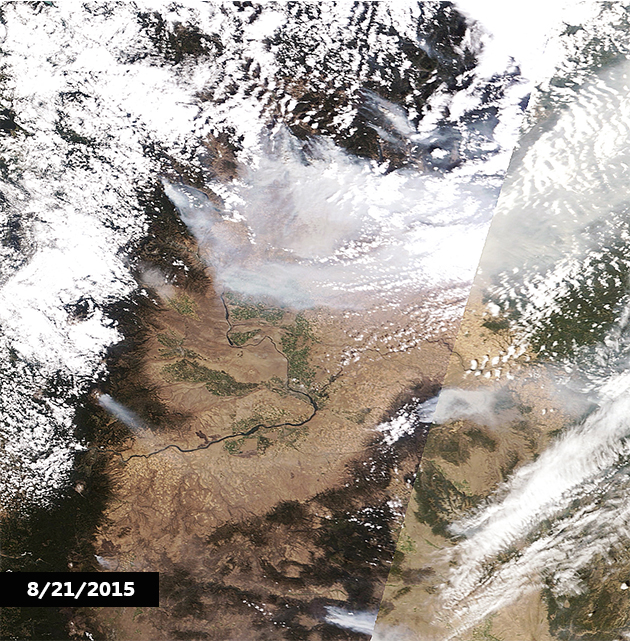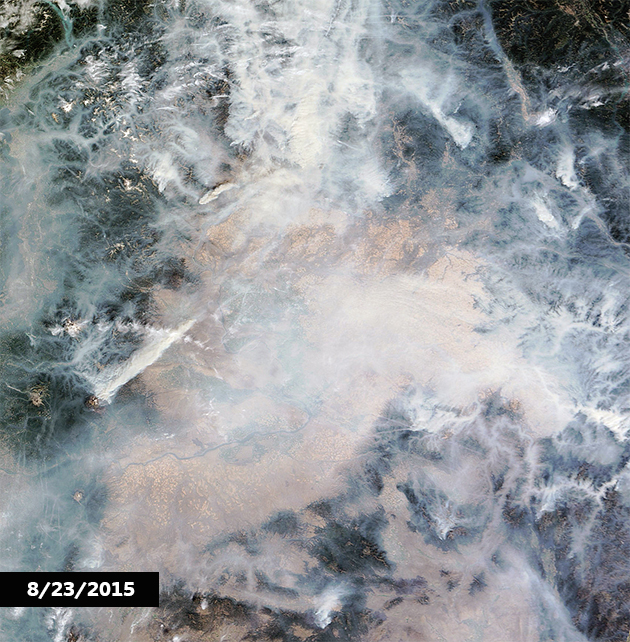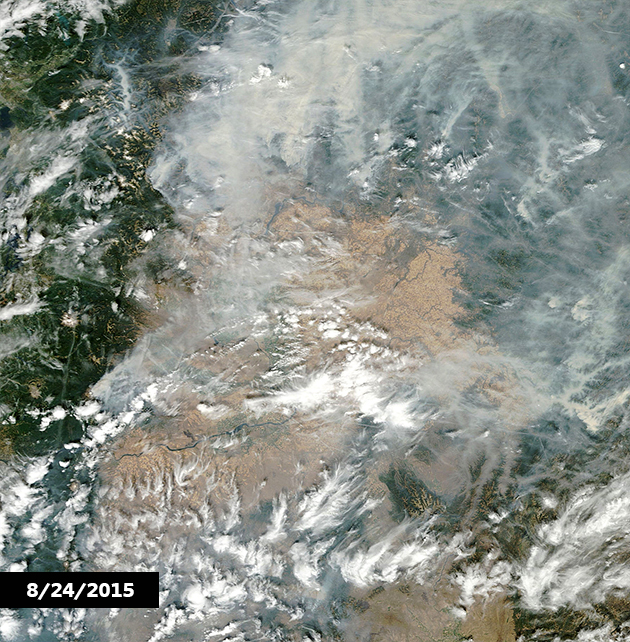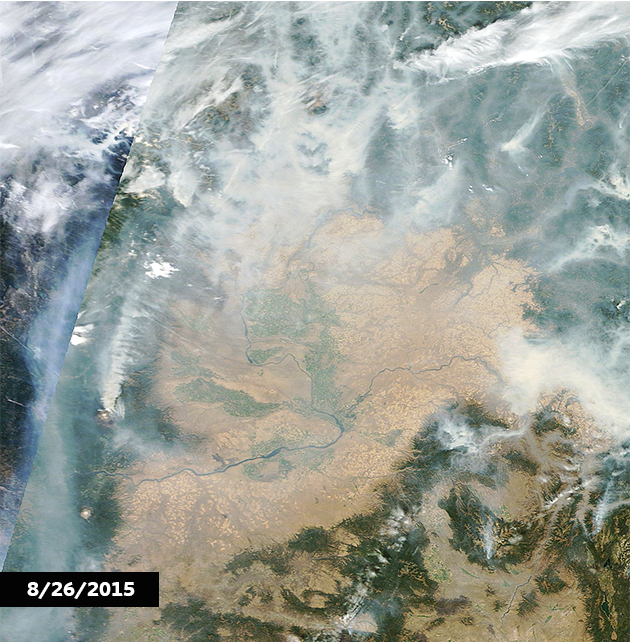The Northeast Washington TREX brings participants into a collaborative environment designed to increase shared stewardship and learning across agencies.
Prescribed-Fire Training Tackles Forest Health, Community Protection
Congress Commits to Solution to Wildfire Funding
How does fire promote forest health?
Controlled Burn Planned for Roslyn Forest Health and Safety
New Training to Expand 'Good Fire' Use Across State, Protect Communities
After the fire: Assessing burned lands
Fires Flow Across the Central Cascades, and the West
2.7M Acres of Forest Need Treatment: How Do We Accomplish That?
Discovering Fire in our Forests
Written & Photographed by Brian Mize, Field Forester
Recently, I was traveling through our Central Cascades lands, noticed a strong odor and saw a small amount of smoke approximately 200’ off the road. I am very familiar with this particular location because it has been a popular spot with the local firewood poachers.
I hiked off the road and found a campfire that had escaped the ring and burned a small area. At that time, the fire was just smoldering and there was nobody around.
Acting quickly, I called the Central Washington Interagency Communication Center in Wenatchee, and they sent out the dispatch to any local fire engines. A Forest Service engine was the first to respond and arrived shortly after. They ran a quick hose line to the fire and extinguished all the heat and put a hand line around the burned area. Afterwards, a Dept. of Natural Resources engine arrived along with a DNR law enforcement officer.
This was clearly a human caused fire, but we did not find any evidence that could pinpoint any specific individuals. There was evidence of recent firewood theft in the immediate vicinity.
Overall, this ended up being a small incident; however, if I had not spotted this fire when I did, it could have developed into something greater in scope. This area is very brushy, steep, and the high temps that day were above 90 degrees. With a little wind, this fire had high potential for spread.
We love that we can provide as much access to the outdoors as possible to our local communities with our lands. It was a good reminder that although fire season has been off to a slow start this summer, we still have a long way to go.
Learn about Fire adapted Communities
What Not To Do When a Wildfire Threatens Your Home
Written by Patricia Sarmiento, Volunteer writer
Photograph by John Marshall
Emotions run high when disaster strikes. That’s why it’s important to educate yourself on disaster preparedness and make plans for what you’ll do during a wildfire before one ever comes your way.
There’s a few do’s and don’ts of reacting to an emergency wildfire situation. Many of us already know the do’s, so here’s a reminder of what you shouldn’t do during a wildfire.
Don’t Assume Everyone’s Clued In
Call 911 immediately–don’t assume someone else already has. Don’t assume your neighbors and local loved ones know about the wildfire breakout, especially if they’re at work or school in another area. Notify everyone of the potential danger.
Go ahead and get in touch with everyone in your family so you can talk about setting your wildfire action plan into motion.
Don’t Leave Your Home without Taking a Few Precautions
Unless you need to leave your home as soon as possible, go ahead and beef up your home’s ability to withstand a nearby fire by taking a few precautions such as:
Removing debris, yard waste, and firewood from your yard
Distancing your grill from your home
Shutting off all gas and propane suppliers
Closing windows, vents, and doors
But remember–lives are always more precious than things. If you feel unsafe while preparing your home for a nearby wildfire, leave immediately.
Don’t Wait to Take Action
Before you take precautions for protecting your home, know what your criteria are for deciding to evacuate. At what point will you know that it’s time to pack up and go?
Having this criteria in mind before you put your home-preparedness plans in motion will help keep you focused during times of panic. Know when you need to drop what you’re doing and get out and don’t be afraid to leave earlier than planned if you feel unsafe.
Don’t Return to Your Home without Permission
If you do evacuate, be prepared to leave for good, or at least for an extended period of time. Don’t return to your home without checking in with the proper authorities first. Don’t assume your neighborhood is safe again when there’s a possibility it might not be.
This is why it’s a good idea to keep a battery-powered radio in your emergency wildfire kit. You’ll be able to tune into the news and stay updated on the status of the wildfire.
Hopefully you’ll never need to use these disaster plans–but if a wildfire ever strikes, you’ll be glad you made them. Remember that when it comes to wildfires and other natural disasters, a detailed plan can be the most powerful tool in your toolkit.
Patricia Sarmiento loves swimming and running. She channels her love of fitness and wellness into blogging about health and health-related topics. She played sports in high school and college and continues to make living an active lifestyle a goal for her and her family. She lives with her husband, two children, and their shih tzu in Maryland.
Changing Our Forests from Top to Bottom
Written & Photographed by Zoe van Duivenbode, Marketing Intern
From bumpy off-roading trails and peaceful stream to exciting wildlife views and forestry education, our trip to The Nature Conservancy’s Manastash-Taneum preserve was nothing short of an adventure. Earlier this week, a group of TNC staff traveled to Cle Elum to learn more about the complex challenges centered around eastern cascade forests, headwaters and communities. This regions checkerboard like landscape, in terms of ownership and management, is slowly transforming into a more unified region for public access and conservation. Under the Tapash Sustainable Forest Collaborative, TNC is partnered with private, state and tribal groups to ensure that these forested lands can be enjoyed by the public and also preserved for wildlife.
Our tour began with a panoramic view that overlooked valleys of densely forested hills with residential communities, Cle Elum Ridge and lake Cle Elum seen in the distance. This viewpoint painted the perfect portrait of some of the challenges TNC faces when planning for restoration and resiliency. Below we could see urban areas vulnerable to forest fires, critical habitat for endangered and threatened fish and wildlife and recreational trails for mountain bikes and off-road vehicles. Our Senior Forest Ecologist, Ryan Haugo, spoke about his plan to manage these lands in a way that positively benefits to both nature and people through large landscape restoration.
While driving through the preserve, we passed through areas that were previously effected by a moderate forest fire a few seasons ago. This burned region provided a great example of the difference between healthy and unhealthy forest fires. As we traveled higher in evaluation, we were lucky to spot four adolescent elk roaming in the woods! We stopped to take photos and watch them dash across the dirt road in front of us. After enjoying a nice lunch along a stream, we continued on and drove beside the riparian forest which lead us to open grass meadows. On our last stop of the tour, we hiked down to a river bed where Emily Howe, Aquatic Ecologist, bravely picked up a large crawdad to assess if it was native or non-native to this region. After a long day spent exploring the forests, riverbeds, and scenic views of TNC’s central cascade preserve, I found myself already planning the next time I can come back.
Interested in visiting preserves like this? Check out our upcoming event to Lake Cle Elum!
Connect and restore forests to break the cycle of megafire
Fragmented ownership and poor management have left our state’s forests primed for catastrophic fire.
Written by Robin Stanton, Media Relations Manager
Photograph by Benj Drummond/LightHawk
Weaving the land back together and implementing big restoration actions that cross ownership boundaries will help prevent megafires.
CONNECTING FORESTS
If you look at a map that shows ownership boundaries in Washington’s eastern forests, you’ll notice a distinctive checkerboard pattern of public and private ownership. That’s a legacy of the land grants of the 1860s, when the federal government gave alternating square miles of land to the railroads to encourage them to reach the West Coast.
Today, that fragmented pattern has led to more development in the midst of the forest where it’s vulnerable to fire and breaks up habitat and recreation areas. It also means forests have been managed piecemeal, without a holistic, science-based plan for largescale restoration.
The Conservancy has been working for more than 10 years to fix this fragmentation, by bringing more of these private lands into public and conservation ownership. Our most recent acquisition of 48,000 acres in the Central Cascades is a big step forward in this work.
RESTORING FORESTS
A recent study by Conservancy and U.S. Forest Service scientists show that 2.88 million acres of eastern Washington forests are in need of restoration, both by thinning trees and using controlled burning to clear out forest fuels that have accumulated for a century.
We’ve led the way with a pilot restoration project on 20,000 acres in the Oak Creek Wildlife Area west of Yakima where we thinned understory trees and shrubs according to a carefully designed plan: Cutting away small 10- and 20-year-old Douglas firs gives 400-year-old ponderosa pines light, air and water to thrive. Thinning smaller trees also prepares the forest for controlled burning, which further enhances the forest’s resilience to future wildfires.
Today, we’re working through the Tapash Sustainable Forest Collaborative (see below) to plan and implement an 80,000-acre restoration project in the Manastash-Taneum area east of Cle Elum. This collaborative restoration will encompass federal, state, and Conservancy forest lands and is expected to get underway this year.
It’s essential that the Conservancy and committed partners act quickly to restore eastern Washington forests to make them less vulnerable to megafires. Forest collaboratives comprised of private stakeholders, as well as state and federal agencies, are coming together across the West to overcome barriers and find solutions to the issue of improving forests’ resiliene and health. The Nature Conservancy is engaged in and is a leading partner of many of these collaborative groups in Washington:
Tapash Sustainable Forest Collaborative: The Conservancy took a lead role in forming the Tapash Sustainable Forest Collaborative in 2006 with the aim of bringing together state and federal agencies, the Yakama Nation, and private landowners to increase the pace, quality, and scale of restoration projects across 2.3 million acres of eastern Washington forest.
Northeast Washington Forestry Coalition: The Nature Conservancy is engaged in the Northeast Washington Forestry Coalition, a group of diverse stakeholders working together since 2002 to promote forest restoration that is beneficial to forest health, public safety, and local economies. The coalition’s priorities, such as fuels reduction projects, serve as examples of successful collaborative work for the public and similar organizations.
North Central Washington Forest Collaborative: The Conservancy is a leading partner in initiating The North Central Washington Forest Collaborative.
The Nature Conservancy helped to establish the Washington Prescribed Fire Council, a coalition of agencies and stakeholders working to safely introduce more prescribed fire into the landscape.
Wildfire Smoke from Space
Graphics by Erica Simek Sloniker, Conservation Information Manager
These Washington wildfires are now the largest in state’s history. Check out these NASA - National Aeronautics and Space Administration maps that capture the past week in smoke from space in the slideshow above, then explore Washington State University’s smoke projection mapping tool!














































































